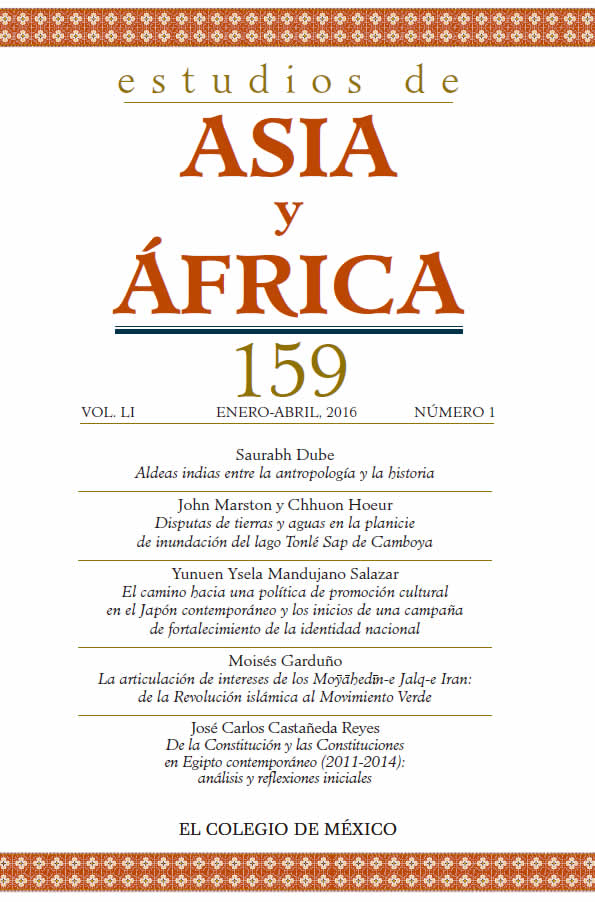Resumen
El presente trabajo aborda la movilización de una comunidad y el conflicto suscitado en torno de los embalses de irrigación en la planicie de inundación del lago Tonlé Sap, en un subdistrito de la provincia de Kampong Thom de Camboya.
Referencias
Banco Mundial, Cambodia: Halving Poverty by 2014? Poverty Assessment 2006, Informe núm. 35213-kh, Nueva York, Banco Mundial.
Bloch, Maurice, “La propiedad y el final de la alianza”, en M. Bloch (comp.), Análisis marxistas y antropología social, Barcelona, Anagrama, 1977, pp. 241-268.
Cambodian Development Resource Institute, Empirical Evidence of Irrigation Management in the Tonle Sap Basin: Issues and Challenges, documento de trabajo núm. 48, Phnom Penh, cdri, 2010.
Cambodian Office of the High Commissioner for Human Rights, “Economic Land Concessions in Cambodia: A Human Rights Perspective”, Phnom Penh, OHCHR, 2007.
Center for Advanced Study, “Justice for the Poor? An Exploratory Study of Collective Grievances and Land and Local Governance in Cambodia”, Phnom Penh, Center for Advanced Study-Banco Mundial, 2006.
Chem, Phalla et al., Framing Research on Water Resources Management and Governance in Cambodia: A Literature Review, Phnom Penh, Cambodia Development Resource Institute, 2008.
Chou, Chea, The Local Governance of Commonpool Resources: The Case of Irrigation Water in Cambodia, Phnom Penh, Cambodia Development Resource Institute, 2010.
Department of Planning and Statistics, Agriculture Census of Cambodia, Phnom Penh, Ministry of Agriculture, Forestry and Fisheries, 18-21 de febrero de 2014.
Diepart, Jean-Christophe, “Cambodian Peasant’s Contribution to Rural Development: A Perspective from Kampong Thom Province”, Biotechnology, Agronomy, Society and Environment, vol. 14, núm. 2, 2010, pp. 321-340.
Diepart, Jean-Christophe, “Problèmes et enjeux de l’économie rurale au Cambodge: Entre nouvelles gouvernances et réalités paysannes: Le cas de la province de Kampong Thom”, tesis de doctorado, Académie Universitaire Wallonie-Bruxelles-Faculté Universitaire des Science Agronomiques de Gembloux, Communauté française de Belgique, 2007.
Diepart, Jean-Christophe, “Recent Land Dynamics in the Tonle Sap Flood Plain and its Impact on the Local Communities”, Tonle Sap Biosphere Reserve Bulletin, vol. 3, 2007, pp. 20-22.
Fox, Jeff y Judy Ledgerwood, “Dry-Season Flood-Recession Rice in the Mekong Delta: Two Thousand Years of Sustainable Agriculture?”, Asian Perspectives, vol. 38, núm. 1, 1999, pp. 37- 50.
Gray, Thomas N. E., Nigel J. Collar, Peter J. A. Davidson et al., “Distribution, Status, and Conservation of the Bengal Florican Houbaropsis Bengalensis in Cambodia”, Bird Conservation International, vol. 19, núm. 1, 2009, pp. 1-14.
Harvey, David, The New Imperialism, Nueva York, Oxford University Press, 2003.
Khiev, Daravy, “Challenge of Participant Irrigation Management in Cambodia: The Case of Damnak Ampil Irrigation Scheme”, tesis de maestría, Universidad de Sidney, Sidney, 2010.
Khouth, Sophakchakrya, “Progress Made on Illegal Reservoirs”, Phnom Penh Post, 9 de marzo de 2011.
Lando, Richard P. y Solieng Mak, Deepwater Rice in Cambodia: A Baseline Survey, Manila, International Rice Research Institute, 1994.
Li, Tania Murray, The Will to Improve: Governmentality, Development, and the Practice of Politics, Durham, Duke University Press, 2007.
Marston, John A. (coord.), Antropología y comunidad en Camboya: Reflexiones sobre la obra de May Ebihara, México, El Colegio de México, 2011.
Middleton, Carl y Tola Prom, “Community Organization for Managing Water Resources around Tonle Sap Lake: A Myth or a Reality”, en Matti Kummu, Marko Keskinen y Olli Varis (comps.), Modern Myths of the Mekong, Helsinki, Universidad Tecnológica de Helsinki, 2008, pp. 149-159.
Muukkonen, Satu, “Water Management in Cambodia–Resources and Relations”, tesis de maestría, Universidad de Helsinki, Helsinki, 2007.
National Institute of Statistics, General Population Census of Cambodia 2008: Provisional Population Totals, Phnom Penh, National Institute of Statistics, 2008.
Ngo, Sothath y Chan Sophal, Does Large Scale Agricultural Investment Benefit the Poor?, Phnom Penh, Cambodian Economic Association, junio de 2010.
Öjendal, Joakim, “Sharing the Good: Modes of Managing Water Resources in the Lower Mekong River Basin”, tesis de doctorado, Universidad de Gotemburgo, Gotemburgo, 2000.
Ostrom, Elinor, Governing the Commons: The Evolution of Institutions for Collective Action, Cambridge-Nueva York, Cambridge University Press, 1990.
Ros, Bandeth, “Participatory Irrigation Management and Factors that Influence the Success of Farmer-Water User Communities: A Case Study in Cambodia”, tesis de maestría, Universidad de Massey, Auckland, 2010.
Sak, R., Human Territoriality: Its Theory and History, Cambridge, Cambridge University Press, 1986.
Sithirith, Mak, Cooperation in the Mekong River Basin: A Reflection of Cambodia’s Experiences in the Development of the Mekong Region, Chiang Mai, Regional Center for Social Science and Sustainable Development, 2007.
Somatra, Kim Sean, “Territoriality and State Power in Cambodia: The Case of Demarcation in Tonle Sap”, tesis de doctorado, Universidad de Sidney, Sidney, 2013.
Someth, P., N. Kubo, H. Tanji y S. Ly, “Ring Dike System to Harness Floodwater from the Mekong River for Paddy Rice Cultivation in the Tonle Sap Lake Floodplain in Cambodia”, Agricultural Water Management, vol. 96, núm. 1, 2009, pp. 100-110.
Un, Kheang y Sokbunthoeun So, “Land Rights in Cambodia: How Neopatrimonial Politics Restricts Land Policy Reform”, Pacific Affairs, vol. 84, núm. 2, 2011, pp. 289-308.
Vandergeest, Peter y Nancy Lee Peluso, “Territorialization and State Power in Thailand”, Theory and Society, vol. 24, núm. 3, 1995, pp. 385-426.
Esta obra está bajo una licencia internacional Creative Commons Atribución-NoComercial-SinDerivadas 4.0.
Derechos de autor 2022 Estudios de Asia y África


